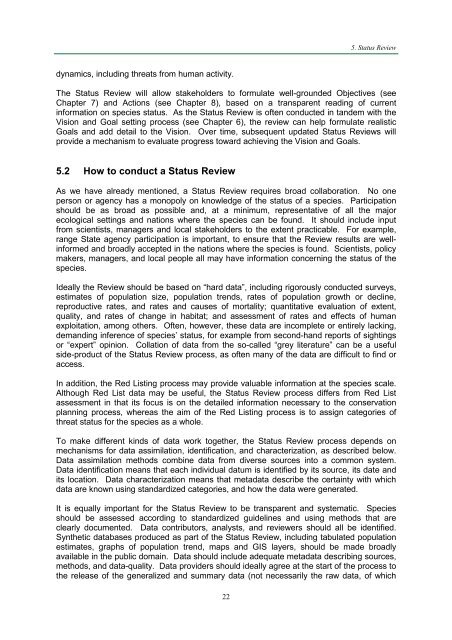Strategic Planning for Species Conservation: A Handbook - IUCN
Strategic Planning for Species Conservation: A Handbook - IUCN
Strategic Planning for Species Conservation: A Handbook - IUCN
Create successful ePaper yourself
Turn your PDF publications into a flip-book with our unique Google optimized e-Paper software.
dynamics, including threats from human activity.<br />
22<br />
5. Status Review<br />
The Status Review will allow stakeholders to <strong>for</strong>mulate well-grounded Objectives (see<br />
Chapter 7) and Actions (see Chapter 8), based on a transparent reading of current<br />
in<strong>for</strong>mation on species status. As the Status Review is often conducted in tandem with the<br />
Vision and Goal setting process (see Chapter 6), the review can help <strong>for</strong>mulate realistic<br />
Goals and add detail to the Vision. Over time, subsequent updated Status Reviews will<br />
provide a mechanism to evaluate progress toward achieving the Vision and Goals.<br />
5.2 How to conduct a Status Review<br />
As we have already mentioned, a Status Review requires broad collaboration. No one<br />
person or agency has a monopoly on knowledge of the status of a species. Participation<br />
should be as broad as possible and, at a minimum, representative of all the major<br />
ecological settings and nations where the species can be found. It should include input<br />
from scientists, managers and local stakeholders to the extent practicable. For example,<br />
range State agency participation is important, to ensure that the Review results are wellin<strong>for</strong>med<br />
and broadly accepted in the nations where the species is found. Scientists, policy<br />
makers, managers, and local people all may have in<strong>for</strong>mation concerning the status of the<br />
species.<br />
Ideally the Review should be based on “hard data”, including rigorously conducted surveys,<br />
estimates of population size, population trends, rates of population growth or decline,<br />
reproductive rates, and rates and causes of mortality; quantitative evaluation of extent,<br />
quality, and rates of change in habitat; and assessment of rates and effects of human<br />
exploitation, among others. Often, however, these data are incomplete or entirely lacking,<br />
demanding inference of species’ status, <strong>for</strong> example from second-hand reports of sightings<br />
or “expert” opinion. Collation of data from the so-called “grey literature” can be a useful<br />
side-product of the Status Review process, as often many of the data are difficult to find or<br />
access.<br />
In addition, the Red Listing process may provide valuable in<strong>for</strong>mation at the species scale.<br />
Although Red List data may be useful, the Status Review process differs from Red List<br />
assessment in that its focus is on the detailed in<strong>for</strong>mation necessary to the conservation<br />
planning process, whereas the aim of the Red Listing process is to assign categories of<br />
threat status <strong>for</strong> the species as a whole.<br />
To make different kinds of data work together, the Status Review process depends on<br />
mechanisms <strong>for</strong> data assimilation, identification, and characterization, as described below.<br />
Data assimilation methods combine data from diverse sources into a common system.<br />
Data identification means that each individual datum is identified by its source, its date and<br />
its location. Data characterization means that metadata describe the certainty with which<br />
data are known using standardized categories, and how the data were generated.<br />
It is equally important <strong>for</strong> the Status Review to be transparent and systematic. <strong>Species</strong><br />
should be assessed according to standardized guidelines and using methods that are<br />
clearly documented. Data contributors, analysts, and reviewers should all be identified.<br />
Synthetic databases produced as part of the Status Review, including tabulated population<br />
estimates, graphs of population trend, maps and GIS layers, should be made broadly<br />
available in the public domain. Data should include adequate metadata describing sources,<br />
methods, and data-quality. Data providers should ideally agree at the start of the process to<br />
the release of the generalized and summary data (not necessarily the raw data, of which

















